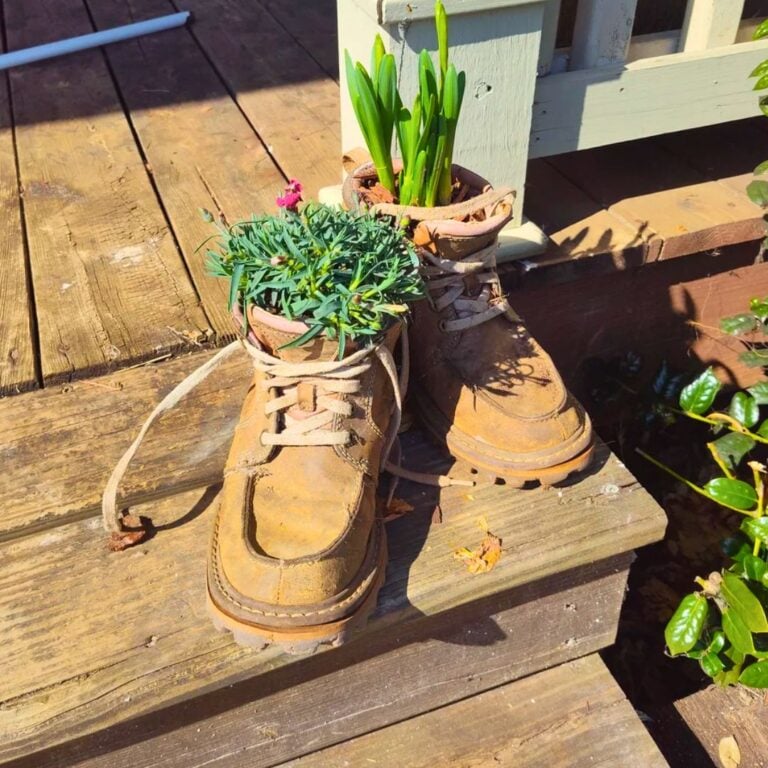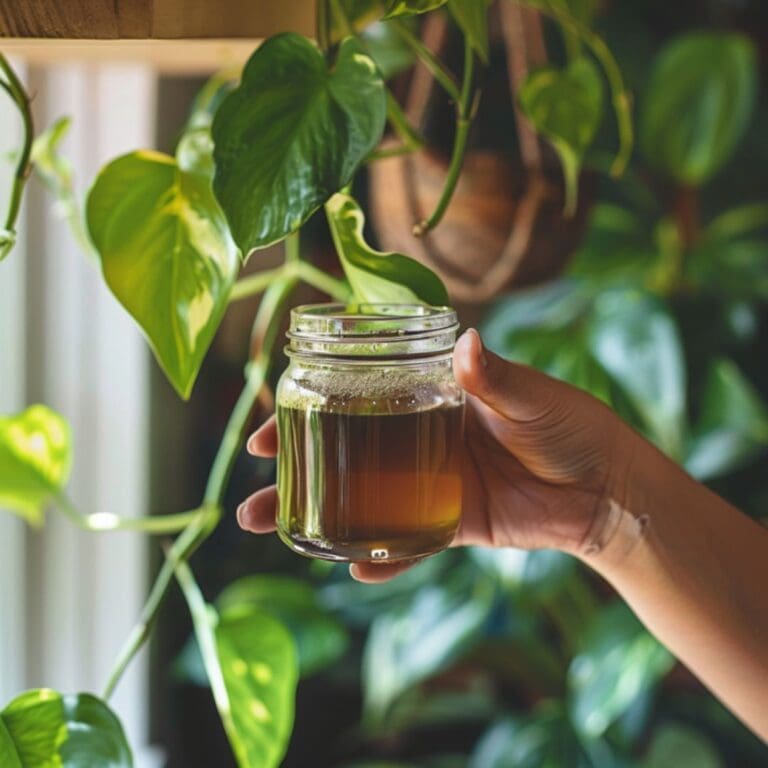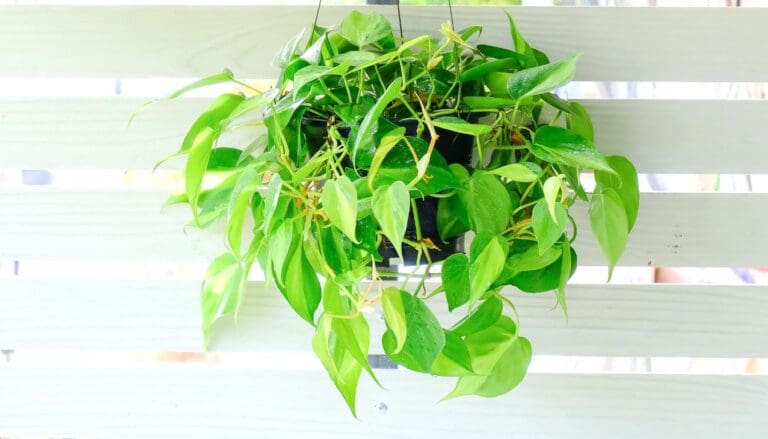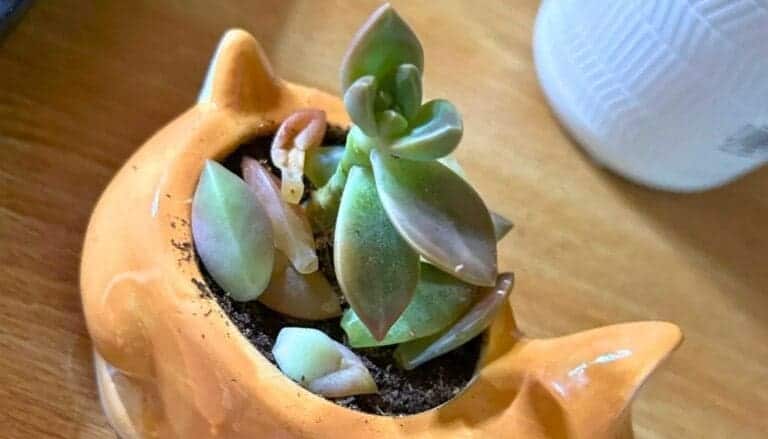10 Plant Shelf Ideas That Work Beautifully In Winter For A Cozy Home
I love finding ways to keep my plants happy when the weather turns cold.
Winter makes it trickier to give them the light and warmth they crave, but honestly, with a few tweaks, you can create a cozy setup that works all season.
You can keep your plants healthy and your space looking fresh just by setting up shelves that fit winter conditions.
I’ve learned that placement, lighting, and picking the right plant types matter a lot. Even small things—like using the right pots or mixing in easy-care greenery—help plants stay strong when days get short.
These ideas make it pretty simple to enjoy greenery indoors without stressing too much.
Please note: Simplify Plants is reader-supported. As an Amazon Associate, I earn from qualifying purchases made by our readers with no extra cost added to you all! Some links in the post are affiliate links and I get a commission from purchases made through links in the post.
1) Use south-facing windows for maximum sunlight
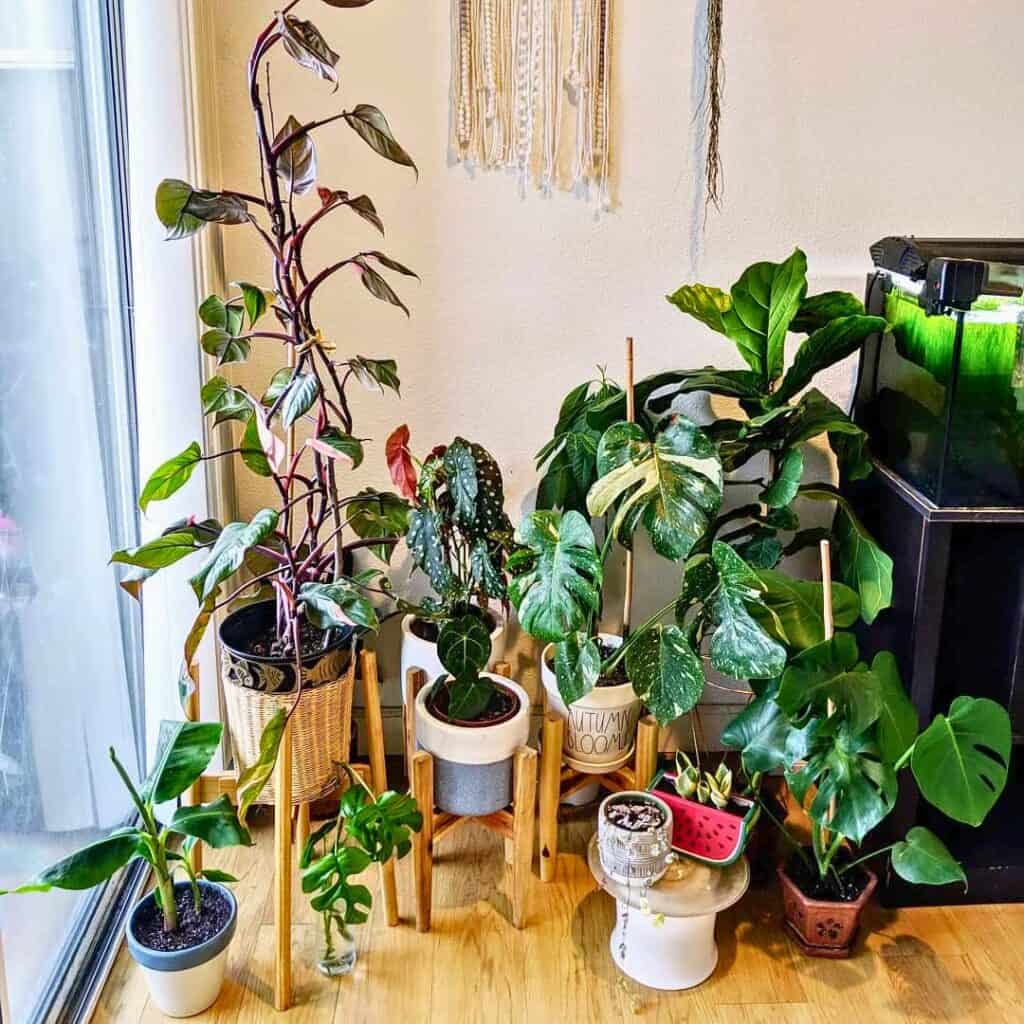
I always put my plants near south-facing windows in winter. These windows get the most direct light during the day, which really helps when the sun isn’t as strong.
When I move my plants here, they seem to grow more evenly and keep their color. If they don’t get enough light, I notice they start leaning or looking washed out.
I try to rotate the pots every week or so. This way, the plants don’t bend toward the window and they grow straighter.
If the glass feels cold, I pull the plants back a bit. That way, they still get the light but aren’t right in the chilly draft.
Honestly, using these windows is probably the easiest way I’ve found to keep plants happy in winter.
2) Add heat-loving succulents like jade plants

I like to keep succulents on my shelves when it’s cold because they handle indoor heat without fuss. Jade plants are a favorite—they stay green and sturdy even when the air feels dry.
I barely have to water them, which is perfect when life gets busy. A little jade plant in a simple pot just looks fresh and clean.
Jade plants really do best near a sunny window. The extra light keeps their leaves firm and bright, which I love.
Sometimes I’ll mix them with other small succulents. The different shapes and greens make the shelf look lively without much effort.
They’re practical, don’t take up much space, and just bring a little spark to my shelves in winter.
3) Incorporate LED grow lights for cloudy days
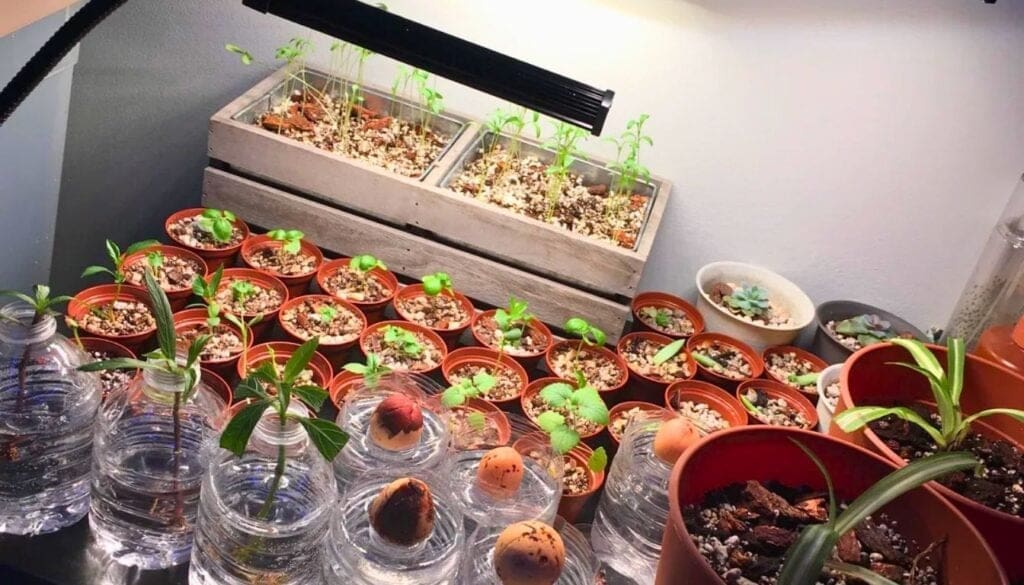
I like using LED grow lights when winter skies are gray for days on end. They give my plants the light they miss when the sun hides, so my shelf stays green.
I set the lights a few inches above the plants for even coverage. Too close, and the leaves get stressed—so I leave a little space.
Usually, I run them for about 10 to 12 hours a day. That keeps things consistent, even if the weather isn’t.
LEDs use less energy than old-school bulbs, so I don’t have to worry about my power bill spiking.
Plus, they don’t give off much heat. My plants stay safe, and I don’t have to shuffle them around to avoid burns.
For shelves in darker corners, these lights are honestly a game-changer. I can finally grow herbs and little flowers in spots that never get direct sun.
Adding a light setup means my plants keep thriving, even in the gloomiest stretch of winter.
4) Place snake plants for low-maintenance greenery

I love using snake plants on my shelves because they need barely any care. They stay green all winter, which is exactly what I want.
Snake plants handle low light like champs. I can tuck them on a shelf in the living room or bedroom and they still look good.
I only water mine when the soil feels dry. That makes things so much easier, especially in winter when I tend to forget.
Their tall, upright leaves add some structure to the shelf. I like pairing them with smaller plants or a few decorative pieces.
I’ve heard snake plants help freshen the air, too. Maybe it’s a small effect, but hey, I’ll take it during the months when the windows stay shut.
Honestly, I just trust my snake plants to stay healthy and green, even when other plants start to look sad.
5) Create a tiered shelf with varying plant heights
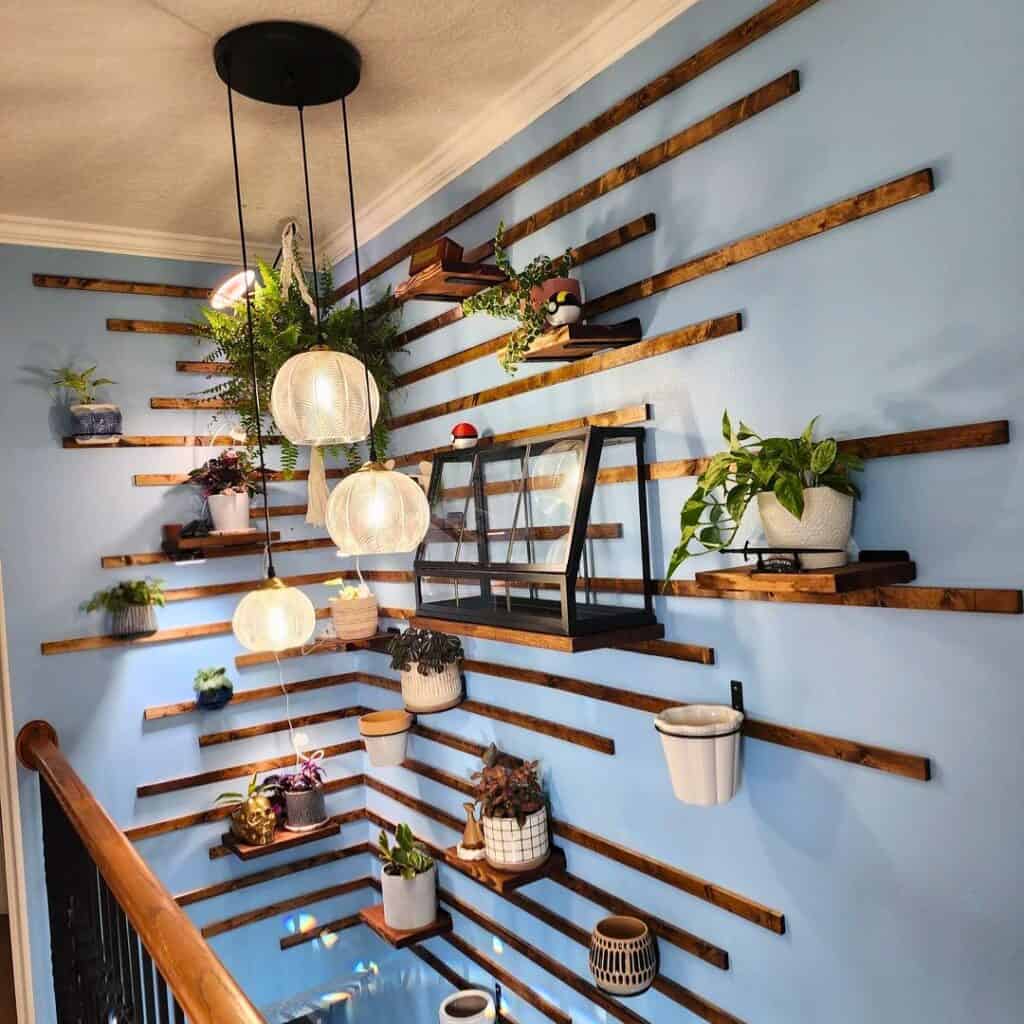
A tiered shelf is just so useful for showing off plants of different sizes without crowding them. The layers make everything visible—nothing stuck in the back.
I put taller plants on top so they get more light and don’t shade the little ones. Medium plants go in the middle, and the smallest ones hang out at the bottom.
It also makes watering simpler. I can reach each pot without playing plant Tetris, and the tiers keep water from dripping down.
Sometimes I mix leafy greens with succulents to add variety. The different shapes and textures just look better when they’re arranged by height.
A tiered shelf is easy to move near a window, too. Every plant gets the light it needs—no need to scatter pots all over the room.
6) Use ceramic pots to retain warmth
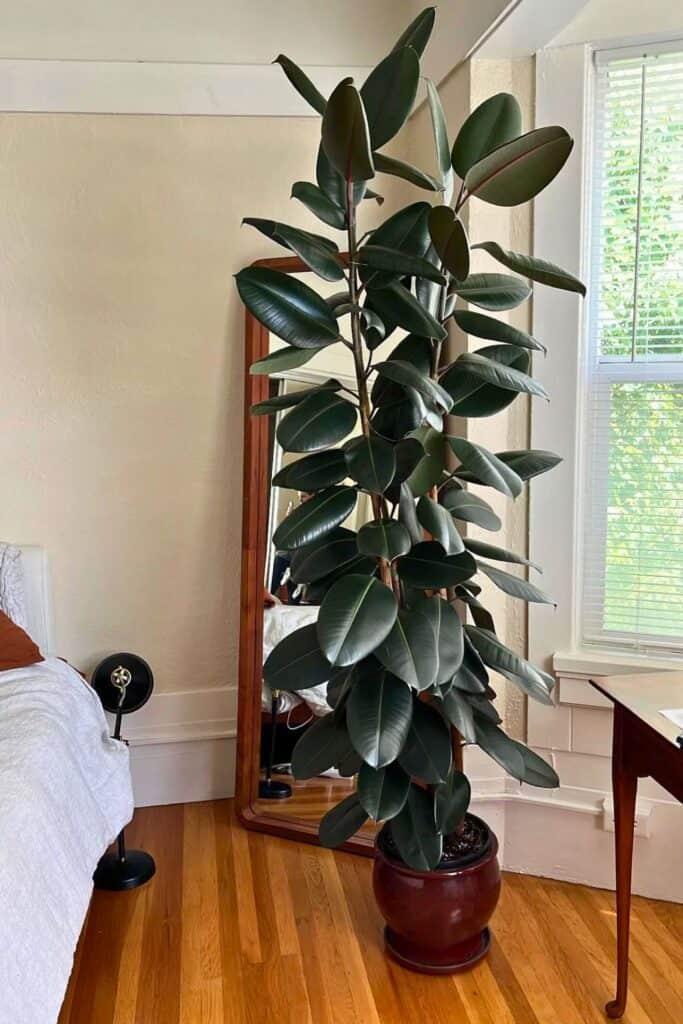
I prefer ceramic pots in winter because they help keep the soil warmer than flimsy plastic. The thicker walls mean the roots don’t get cold as fast.
Ceramic also holds moisture longer, so I don’t have to water as much. That’s helpful when plants need less water anyway.
They just look nice on shelves, honestly. With all the colors and finishes, it’s easy to match them to my space.
They feel sturdy and reliable—I don’t worry about them tipping over, even on higher shelves.
I always check for drainage holes, though. Extra water pooling at the bottom is a no-go for healthy roots.
Ceramic pots just balance style and function. They keep my plants cozy and add a polished look to my winter shelf.
7) Include air-purifying plants like peace lilies
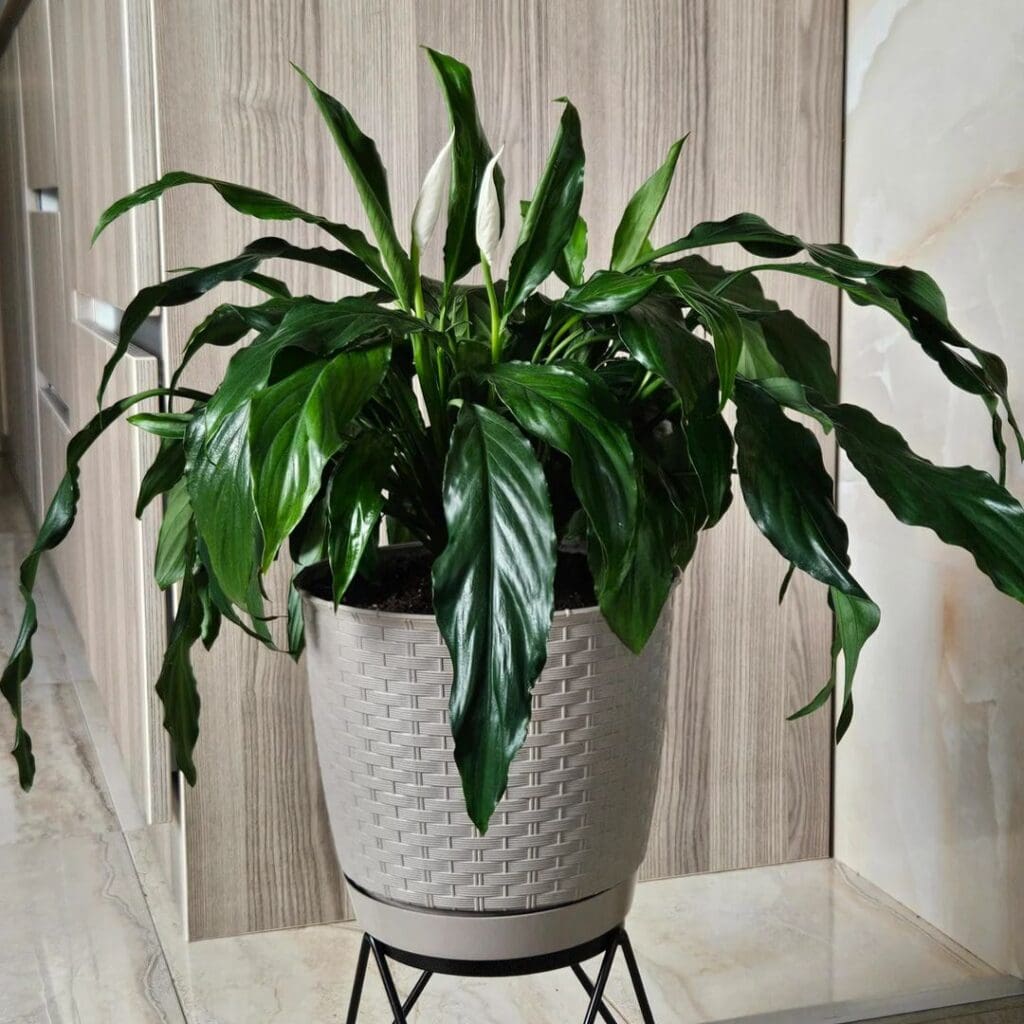
Adding peace lilies to my shelves in winter just feels right. Their green leaves and white blooms really pop against the cold season.
They’re known for their air-purifying qualities, which is a nice bonus. Sometimes I think the air feels lighter with a few of them around.
Peace lilies don’t need much light, so they’re great for shelves away from windows. I just water them when the soil dries out.
Mixing them with low-maintenance plants like snake plants or pothos keeps things simple. The display looks healthy and doesn’t take much effort.
Grouping peace lilies on a shelf adds a calm, natural touch. The green and white mix makes the space feel more welcoming.
8) Add trailing pothos for a cascading effect

I love using pothos on my shelves because their vines trail down in such a relaxed, pretty way. It just makes the space feel softer.
They’re easy to care for, which is a relief in winter. I don’t need to water them much, and they still look great.
On the top shelf, the vines hang down and fill empty space. The shelf looks fuller without piling on more stuff.
I like mixing pothos with upright plants. The combo of tall and trailing adds balance and keeps things interesting.
They keep their color best with good light. I usually stick mine near a window for that indirect sunlight.
If the vines get too long, I just snip them and root the cuttings in water. New plants for free—who doesn’t love that?
Even just one pothos can totally change the vibe of a winter shelf.
9) Mix evergreens like small cypress trees
I like adding small cypress trees to my shelves in winter. They stay green and fresh, which is nice when other plants fade.
Their simple shape keeps the shelf looking tidy. I usually put a cypress in a clay or ceramic pot for a clean look.
Neutral containers help the green stand out more. I think it just looks better that way.
To keep things interesting, I mix cypress with other small plants. Pairing them with succulents or ivy adds some variety in size and texture.
I like adding a few seasonal accents too—like pinecones or pebbles. Those little details make the shelf feel cozy.
Cypress trees stay compact, so they fit on shelves easily. I don’t have to trim them much, which is a plus.
Placing them near a window gives them enough light during short winter days. I keep an eye on the soil since pots dry out faster indoors, and sometimes give the foliage a light misting to keep it fresh.
Mixing evergreens with other plants makes the shelf feel full but not crowded. The steady green of the cypress ties everything together and adds a calm vibe for winter.
10) Use moss to cover soil for moisture retention

I like to add moss on top of the soil in my plant pots during winter. It keeps the soil from drying out too fast, especially when the air in my place feels dry.
The moss acts as a natural cover that holds in moisture. That means I don’t have to water my plants as often, which helps prevent overwatering.
Honestly, I also just love how moss gives my plant shelf a soft, green look. It makes the pots look more finished—kind of cozy—and adds a little nature to the space.
When I use moss, I notice the soil stays evenly damp for a lot longer. This is super helpful for plants that need steady moisture through the colder months.
I usually go for preserved moss since it’s easy to find and simple to use. I just press it gently on top of the soil, and it tends to stay put without much fuss.
Moss works for both small pots and bigger containers. No matter the size, it helps create a neat and tidy surface instead of just bare dirt.
I’ve also found moss cuts down on the mess from watering. The soil doesn’t splash up as much, so my shelves stay cleaner.
For me, it’s a small step that makes plant care easier and honestly just more enjoyable in winter.
Choosing the Right Plants for Winter Shelves
I focus on plants that can handle less sunlight and cooler indoor air. I also pay attention to how much moisture and warmth each plant needs so they stay healthy through the season.
Low-Light Tolerant Varieties
In winter, shorter days mean less sunlight reaches my shelves. I go for plants that thrive in shade or indirect light, so they don’t end up struggling.
Some of my favorites include:
- Snake Plant – grows well even in dim corners
- ZZ Plant – needs very little care and light
- Pothos – trails beautifully and adapts to low light
- Philodendron – easy to grow with minimal sun
I skip plants that demand bright light since they usually fade or drop leaves indoors during winter.
I also rotate my pots every few weeks. This helps each side of the plant get equal light, even if it’s just from a window.
With low-light plants, this small step actually makes a noticeable difference.
Humidity and Temperature Considerations
Indoor air often gets dry from heating systems, and this can stress plants. I pick varieties that handle drier air, like succulents, cacti, and spider plants.
For plants that need more moisture, I use simple tricks:
- Place a tray of water with pebbles under the pot
- Group plants together to create a small humid zone
- Mist leaves lightly, but not too often
Temperature matters too. I keep plants away from drafty windows, heaters, and vents. Sudden changes can really shock them.
I stick to plants that prefer steady room temperatures, usually between 60–75°F, since that matches most homes in winter.
This way, my shelves look green without me having to worry all the time.
Styling and Maintenance Tips
I keep my plants healthy in winter by paying attention to how much light they get and how often I water them. Small changes in routine can make a big difference when the days are short and the air is dry.
Maximizing Natural Light
I move my plant shelves closer to south-facing or east-facing windows because those spots get the most daylight in winter. If a window is blocked or too shaded, I use a full-spectrum grow light to make up for the lack of sun.
To avoid uneven growth, I rotate my pots every week. This helps each side of the plant get light and keeps them from leaning too much toward the window.
I also make sure my windows are clean. Even a thin layer of dust or dirt can block a surprising amount of sunlight.
For shelves that sit far from windows, I use clip-on grow lights. They’re small, easy to adjust, and give plants the boost they need when natural light just isn’t cutting it.
Winter Watering Guidelines
I water less often in winter because most plants just grow slower in colder months. I always check the soil with my finger before watering.
If the top inch feels dry, then it’s time to add water. Overwatering is a common problem, so I use pots with drainage holes to protect roots from sitting in soggy soil.
I also group plants with similar water needs together. It makes it easier to keep track and stops me from giving too much or too little water to the wrong plant.
For plants that like humidity, I place a tray of water with pebbles under the shelf. This adds gentle moisture to the air without soaking the soil.
Frequently Asked Questions
I focus on keeping plants healthy in dry air, finding smart ways to show off succulents, and making sure shelves get enough light. I also look at which plants do well in winter, how to save space, and how to make displays feel cozy.
How can I protect my indoor plants from the dry winter air?
I use a small humidifier near my shelves to keep moisture in the air. I also group plants together because this helps them hold humidity better.
What are some creative ways to display succulents during colder months?
I like to place succulents in shallow trays filled with pebbles for a clean look. Using tiered shelves lets me show off different shapes and colors without taking up much room.
Can you suggest any winter-friendly plants that thrive on shelves?
I keep snake plants and jade plants on my shelves because they handle winter well. Both need little care and stay green even when the air is dry.
How do I ensure adequate light for my plant shelf in shorter winter days?
I move my plants to south-facing windows for the strongest sunlight. On cloudy days, I switch on LED grow lights to keep them healthy.
What are some tips for arranging a plant shelf in a small space?
I use a tiered shelf so each plant gets light without blocking the others. Mixing tall and short plants makes the shelf look balanced and saves space.
How can I add a touch of warmth to my plant display when it’s cold outside?
Honestly, I love using warm-toned pots—they just make everything feel a bit more inviting. Sometimes I’ll wrap a few string lights around the shelf too, which gives off a gentle glow at night.
Natural wood shelves are a game changer for that extra cozy vibe in winter. There’s just something about the look of wood and greenery together, isn’t there?
Recommended Garden Supplies
| Product Image | Our Recommended Gardening Supplies | Check Offers! |
|---|---|---|
Top Top
Top
Top
Top
Top
Top
Top
Top | rePotme Houseplant and Tropical Classic Potting Soil Mix | Check Offer On Amazon |
 Top
Top
Top
Top
Top
Top
Top
Top | Espoma Organic Indoor Plant Food | Check Offer On Amazon |
 Top
Top
Top
Top
Top
Top
Top
Top | GooingTop LED Grow Light 6000K Full Spectrum Clip Plant Growing Lamp | Check Offer On Amazon |
 Top
Top
Top
Top
Top
Top
Top
Top | Soil Moisture Meter | Check Offer On Amazon |
 Top
Top
Top
Top
Top
Top
Top
Top | Govee Hygrometer Thermometer, Bluetooth Enabled! | Check Offer On Amazon |
 Top
Top | LEVOIT Humidifiers for Large Room(Best For Plants) | Check Offer On Amazon |
 Top
Top
Top
Top
Top
Top
Top
Top | Upgraded DIY Automatic Drip Irrigation Kit, 15 Potted Houseplants Support | Check Offer On Amazon |
 Top
Top
Top
Top
Top
Top
Top
Top | Stainless Steel Heavy Duty Gardening Tool Set | Check Offer On Amazon |
 Top
Top
Top
Top
Top
Top
Top
Top | Bonide Insecticidal Soap | Check Offer On Amazon |
 Top
Top
Top
Top
Top
Top
Top
Top | Bonide 32 oz Spray Neem Oil for Organic Gardening | Check Offer On Amazon |
 Top
Top
Top
Top
Top
Top
Top
Top | Garden Safe Fungicide | Check Offer On Amazon |

